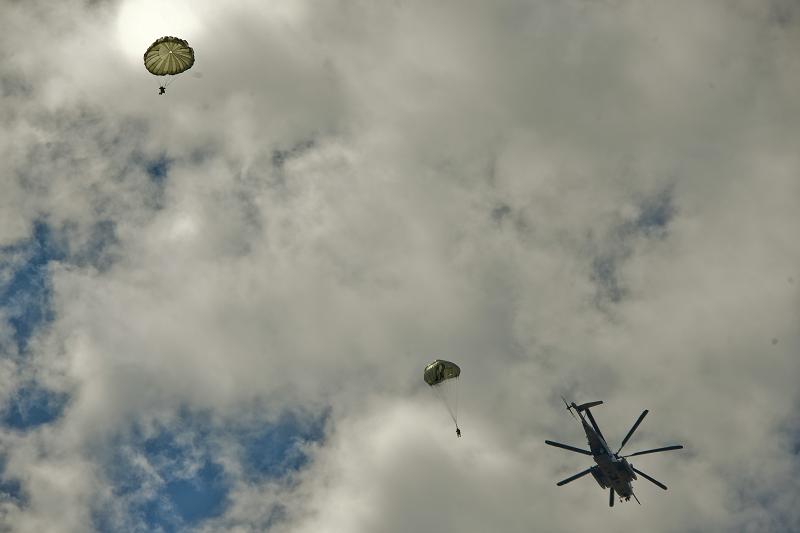 JOINT BASE MCGUIRE-DIX-LAKEHURST, N.J. – Paratroopers with 404th Civil Affairs Battalion, United States Civil Affairs & Psychological Operations Command (Airborne), jump out of a Sikorsky CH-53 Sea Stallion Helicopter during a large scale airborne operation here on Aug. 14, 2020. The unit conducted non-tactical airborne operations in order to maintain mission readiness and proficiency among their paratroopers.(U.S. Army Photo By: Sgt. 1st Class Gregory Williams, 361st Theater Public Affairs Support Element/Released)
JOINT BASE MCGUIRE-DIX-LAKEHURST, N.J. – Paratroopers with 404th Civil Affairs Battalion, United States Civil Affairs & Psychological Operations Command (Airborne), jump out of a Sikorsky CH-53 Sea Stallion Helicopter during a large scale airborne operation here on Aug. 14, 2020. The unit conducted non-tactical airborne operations in order to maintain mission readiness and proficiency among their paratroopers.(U.S. Army Photo By: Sgt. 1st Class Gregory Williams, 361st Theater Public Affairs Support Element/Released)
JOINT BASE MCGUIRE-LAKEHURST, N.J. — Over time skills can be acquired and sharpened, but if they’re not used they end up being diminished. When units go to the shooting range and hone their ability to qualify on an M4 rifle, they receive ammunition support from a range detail.
In the same fashion, paratroopers rely on support from a drop zone detail charged with ensuring the safety of their jumpers. Those duties range from measuring wind gusts, to the placement of neon-colored velocity 17 panel markers along the field; mission success is truly a team effort.
After a year-long hiatus, the 404th Civil Affairs Battalion conducted a large-scale airborne operation here on Aug. 14, 2020.
“Not only are we dealing with an actual mission and must complete our tasks, but we're dealing with somebody's life,” said Spc. Jessica Romeo, a supply specialist with the locally based Headquarters and Headquarters Company, 404th Civil Affairs Battalion. “Dropping from an aircraft is very dangerous so we have to make sure we always have the right equipment on standby and make sure that we're always ready.
Before parachutes fill the open sky, the drop zone detail calculates wind speed, knots, and distances. The detail uses red balloons to measure wind gusts and time their deployment from the ground to a wind ceiling, which reaches 1,200 feet in the air. Any slight miscalculations could mean the difference between boots hitting the ground or chutes being stuck in a tree.
“We have bad days, but we have to work past those bad days. This is not something that we do for fun,” Spc. Romeo said. “This is our life and somebody could seriously get hurt doing this,”
Dependent on the unit’s policy, any Soldier regardless of their military occupational specialty can be a part of a DZ detail, with DZ detail leaders identifying prerequisites that meet their criteria. Being a part of a DZ detail does come with its advantages as Soldiers work directly with the Jumpmasters who guide and mentor them throughout the intricacies of conducting airborne operations.
"Safety is paramount to an airborne operation, and that safety comes from the dedication and professionalism of all participants," Chief Warrant Officer 5 Michael A. Rich, command chief warrant officer with the United States Army Civil Affairs & Psychological Operations Command (Airborne), said. "This trust, skill, and professionalism only comes through experience, and we must continue to expand our experience to increase and maintain proficiency," Chief Warrant Officer 5 Rich said.
As airborne operations continue to build, the drop zone detail sets the stage for paratroopers, who’ve been rehearsing proper procedures on exiting an aircraft all morning with jump masters. One of those paratroopers, a former Marine turned civil affairs Soldier, Sgt. 1st Class Raheem Townes, a team sergeant with Charlie Company, 404th Civil Affairs Battalion, waits patiently in the holding area for his chalk to be called up.
“Sometimes it's not the landing, but it's what's under you,” Sgt. 1st Class Townes said. “I did a jump two years ago in a big open field and I find the smallest piece of blended concrete that I can land on. I thought to myself ‘All this space and this is what I find.’’”
Sgt. 1st Class Townes said he’s experienced some bad jumps, but he continues to be in awe of the capability he’s part of with being jump qualified. “I've been in the airborne program since 2013 and it's one of the freest feelings in the world for me,” Sgt. 1st Class Townes said. “I keep thinking, wow, most Army Reserve Soldiers don’t get this kind of opportunity.”
As Jumpmasters load paratroopers on board a Sikorsky CH-53 Sea Stallion Helicopter and take off into the sky, the Jumpmasters in the air and DZ detail maintain communication working in concert with one another.
"We have to remember that each jumper is entrusting his/her life on the judgment and skill of the Jumpmasters involved," Chief Warrant Officer 5 Rich said. "Because in this type of operation, there has to be absolute understanding between the Jumpmaster/pathfinder on the ground and the Jumpmasters in the aircraft for it to work."
As paratroopers fill the skies and navigate the winds, members of the DZ detail look on and later celebrate the successful execution of the battalion wide airborne operation.
“We need the interaction with each other,” Sgt. 1st Class Townes said. “That camaraderie is what allows us to get on the plane and go to some austere environment knowing that I'm here for the person next to me. We’re a family and it's a legacy.”
No matter if a Soldier is a jumper or a member of a detail, each position is important to completing the mission and making sure the unit is ready to answer our nations call.
Distributed by permission of DOD.


